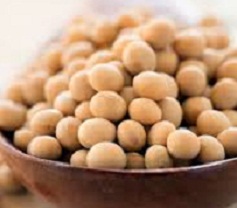Soya Beans: Nutrition, Benefits, Types, Uses and Side Effects
Soya beans (Glycine max L.) are one of the healthy whole grains existing on earth, it has been around for long and each year people keep finding out its benefits.

Soy and soy foods are common in Asian cuisine particularly for people following vegetarian and vegan diets that often use soy to replace meat.
Specially for You >>> How to Peel Beans with Hands
Soya milk and cheese are a good example for those looking to replace dairy in their diet
People eat Soya beans, drink them in milk alternatives, and consume them in the form of supplements.
This is because of their high-quality protein content, and their capability to be processed into milk and meat substitutes.
What Are Soya Beans?
Soya beans are members of the pea (legume) family and are native to East Asia. They have been a vital source of protein in the Orient for many years.
Is Soya Bean and Soybean the Same?
Soya beans and soybeans are precisely the same and the names are the same according to fashion, habit, or preference.
The end products, such as soya/soy sauce, soya/soy oil are also the same no matter whichever spelling is used.
It is known as soy in the US, and they are legumes found in miso, tofu, edamame, and tempeh and of course soya milk.
It seems like everything you eat, there is soy in it. Even the healthy, whole foods-organic stuff, there is always soy in it.
I love soybeans because it’s very nutritious and good for my baby. And when I process it myself, I’m sure it’s well processed for best results
Soybeans contain phytonutrients and antioxidants that are linked to various health benefits. Though, concerns have been raised about potential adverse effects.
This article tells you all you need to know about soya beans.
Nutrition Facts of Soya Beans
Soybeans are mainly composed of protein but also contain good amounts of carbs and fat.
The nutrition facts for 100 grams of boiled soybeans are:
- Calories: 173
- Water: 63%
- Protein: 16.6 grams
- Carbs: 9.9 grams
- Sugar: 3 grams
- Fiber: 6 grams
- Fat: 9 grams
- Saturated: 1.3 grams
- Monounsaturated: 1.98 grams
- Polyunsaturated: 5.06 grams
- Omega-3: 0.6 grams
- Omega-6: 4.47 g
Protein
Soya beans are among the best sources of plant-based protein and a decent source of both carbs and fat. The protein content of soybeans is 36–56% of the dry weight.
What’s more, they are a rich source of various vitamins, minerals, and beneficial plant compounds, such as isoflavones, and have been associated with beneficial health effects.
Health Benefits of Soya Beans
Like most whole foods, soybeans have several beneficial health effects.
- Soybeans contain plant compounds that may assist in preventing breast and prostate cancer. That’s why; these legumes may relieve menopause symptoms and cut the risk of osteoporosis in postmenopausal women.
- Consuming soybean-based foods may lessen the risk of various health problems, including stroke, cardiovascular disease, coronary heart disease (CHD), and improve bone health.
- On the other hand, eating soybean-based foods can cause digestive problems and suppress thyroid function in predisposed individuals.
Concerns and Side Effects
Even though, soybeans have many health benefits, some folks need to limit their consumption of soy products or even avoid them completely.
- Suppression of thyroid function
High intake of soy products may suppress thyroid function in some people and contribute to hypothyroidism – a condition characterized by low production of thyroid hormones
- Flatulence and diarrhea
Like most beans, soya beans contain insoluble fibers, which may cause flatulence and diarrhea in sensitive individuals.
Soy Allergy
Food allergy is a popular condition triggered by a harmful immune reaction to certain components in foods.
Soy allergy is caused by soy proteins – glycinin and conglycinin – found in most soy products.
Soy allergies are also common in babies and children.
Storing Soybeans
Edamame, or fresh soybeans should be refrigerated and used within two days.
Frozen edamame can be stored in the freezer for many months.
Dried soya beans can be kept in an airtight container for a very long period.
Soy Products
Soybeans can be taken in many ways. Foods made from soybeans can be shared into unfermented and fermented foods.
Under unfermented foods, we have – soy milk, tofu, edamame, soy nuts, and sprouts, while fermented soy products include – natto, miso, tempeh, and soy sauce.
Some soy products such as tofu or tempeh are sources of calcium and iron being made with a calcium coagulant and calcium-fortified soy drinks.
Not too processed organic soy is the most healthful option. Some examples include:
- Cooked soybeans
- Edamame
- Tempeh
- Soy nuts
- Soy milk
- Tofu
Types and Uses
Soybeans come in many colors, including:
- Green soybeans:Young green soybeans are also called edamame. Shelled edamame is an appetizer and also available in salads, stir-fries, and soups.
- Yellow soybeans:Manufacturers usually use yellow soybeans to make soy milk, soy flour for baking tofu, tempeh, and tamari.
- Black soybeans:Some Asian food cultures use simmered or fermented black soybeans in traditional cuisines.
Uses of Soybeans
- Food for Humans
Nearly all soybeans are processed for their oil
Soybean oil is used in cooking or as an ingredient. Margarine is a product made from soybean oil. Salad dressings and mayonnaise are made with soybean oil.
The remaining material after removing the oil can be used to make food for farm animals and pets.
- Feed for Animals
The high-protein fiber (that which remains after processing has removed the oil) is grilled and prepared into animal feed for pork, poultry, cattle, other farm animals, and pets.
Other Uses
- Bio diesel – bio diesel fuel for diesel engines can be produced from soybean oil using an easy process called transesterification.
- Bio composites are building materials made from soya beans and recycled newspaper.
- Laminated plywood, particleboard, and finger-jointed lumber are made with soy-based wood adhesives.
- Soy products can be seen in many common brands of home, and in auto upholstery applications.
- Soy is one of the ingredients in many industrial lubricants, cleaners, solvents, and paints.
- Candles made with soybean oil burn with less smoke and soot and it lasts longer.
- Soy ink is better than petroleum-based inks because soy ink is renewable, not toxic, and environmentally friendly, and it cleans up easily and faster likewise the crayon.
- Soy-based hydraulic fluid and rail flange lubricants are as good as petroleum-based lubricants
.


